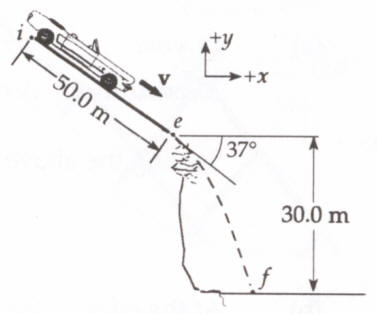
The formulas for projectile motion are identical to those of kinematics, except that the x- and y-components of displacement and velocity are treated separately. In most cases, the horizontal acceleration is zero and the vertical acceleration is directed straight down with a value of g=9.8 m/s2.

Solution: This is a straight-forward projectile motion problem with a
horizontally directed launch.
![]()


To figure out the minimum velocity, we can solve for the velocity as a function of angle and look at the graph. This Excel sheet demonstrates the procedure.
Sample problem:
A basketball player is standing on the floor 10.0 m from the basket, as shown.
The height of the basket is 3.05 m, and he shoots the ball at a 40.0o
angle with the horizontal from a height of 2.00 m. At what speed must the player
throw the basketball so that the ball goes through the hoop without striking the
backboard?
Solution: This is a typical projectile motion problem for
which we need to set up two equations (x and y) to solve for two unknowns.

Sample problem: A car is parked on a cliff overlooking the ocean on an
incline that makes an angle of 37° below the horizontal. The negligent driver
leaves the car in neutral, and the emergency brakes are defective. The car rolls
from rest down the incline with a constant acceleration of 4 m/s2 for
a distance of 50 m to the edge of the cliff. If the cliff is 30 m above the
ocean, find the car's position relative to the base of the cliff when the car
lands in the ocean.
Solution: This problem combines one-dimensional accelerated motion with
projectile motion. It also offers an opportunity to review the
quadratic equation.
 |

|
In those cases in which the vertical displacement is zero, the horizontal displacement (also known as range) can be expressed in terms of initial launch speed and angle:

Caution: This formula is only true when the initial and final heights are the same.
When the vertical displacement is zero, complementary launch angles result in the same horizontal range.
Sample problem: A hunter aims his arrow directly at a target (on the same level)
100 m away. If the arrow leaves the bow at a speed of 75 m/s, by how much will
it miss the target? What should be the launch angle to hit the target?

Solution:
Return to class notes TOC.
Page last modified: